The residents of Moras, a tiny hamlet in Spain’s Almería countryside, talk often of the past. Lush green valleys with pools and ponds, an abundance of wildlife, and their plots of fertile orchards, where villagers grew vegetables and raised livestock.
“There was a lagoon, and it had a little sandy beach,” says Moras local Juani Marín, who has lived in the village her entire life. “I used to bathe there when I was young. It disappeared."
“This was a paradise,” 72-year-old Juan José Martínez, Juani’s uncle and a former mayor of Moras (who, sadly, died this December), tells us. “Now everything has dried.”
The source of Moras’s former splendour is its qanat, a five-foot-tall and two-foot-wide pitch-dark tunnel that stretches far under the rocky hillside. Hand-carved during the Moorish rule of Andalusia more than 500 years ago, this underground aqueduct has brought water to the village of Moras for centuries.
At the qanat’s end, after 187 metres of muddy sludge and camps of sleeping bats, is a humble pool of standing water. It is an ancient spring fed by the vast subterranean reservoir of the Sorbas aquifer.
Juani's husband, Luis Braut, 54, a municipal worker, gestures how much the water level has dropped over time. Where once water gushed from the earth, it now sits languid, a relic of the past. Today, many of the houses in the village stand empty and its orchards dried up or abandoned. Once home to 60 or so residents, Moras now sustains barely a dozen, most of them elderly.
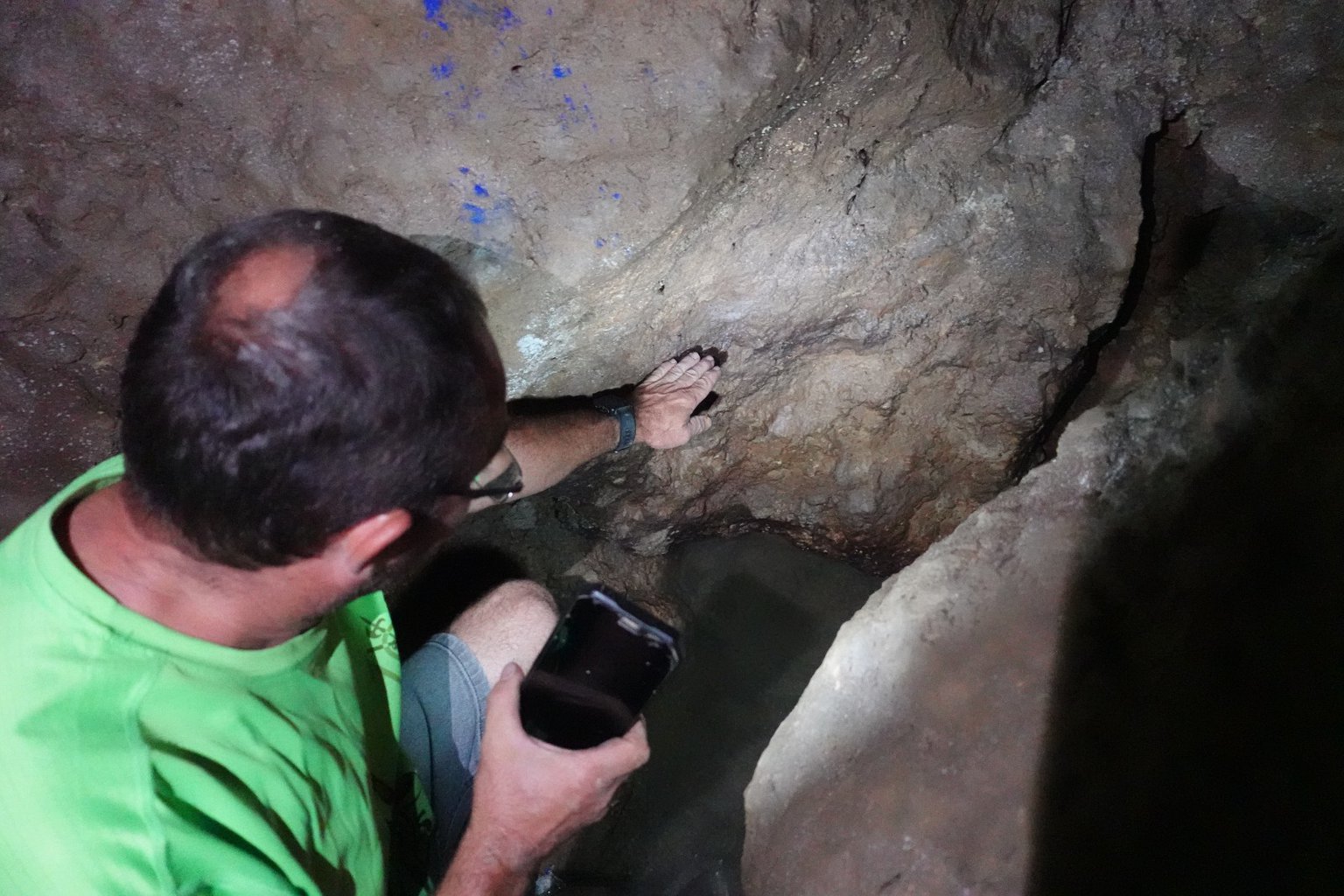
Inside the Moras's qanat, Luis Braut shows us how much the water level has dropped in recent years (credit/Craig Shaw)
Those who remain suffer under extreme heat and lack of water, which has brought neighbourly conflict. For the past few years, someone in the village has been sabotaging the irrigation channel, cutting off what little water remains. "When you irrigate one orchard, you can't irrigate the other,” explains Juani. “That's where the problems arise."
The culprit, they say, is the village’s last small farmer, Andrés Máñez. Máñez, who cites his age as around 90 but cannot be sure, is quiet on the accusations against him. “Water here is a misery,” he tells us. “There are many disputes because you want to irrigate, I want to irrigate. And there is not enough water for everyone."
When we visited Moras in late summer, it had rained once, in June. Drinking water is delivered weekly from a nearby town, echoing similar stories across Almería and the country. After another year of record-breaking temperatures in Spain, the government declared a drought and petitioned the EU for emergency funds to tackle a worsening crisis.
The wrangling over such a fundamental natural resource has led to protests from farmers and international diplomatic challenges. Water featured in the run-up to the snap elections in July, with right-wing parties like VOX ramping up their courtship of farming interests in places like Almería.
Politically, Moras is diverse —some vote for the far-right Vox party, others for the conservative People’s Party. Many, like Juan Jose, are traditional PSOE socialists. But ideology doesn't matter. Water is the real politics here. One point of agreement among the residents is what — and who — is to blame for Moras’s misery: olives and Spain’s booming agricultural export industry.
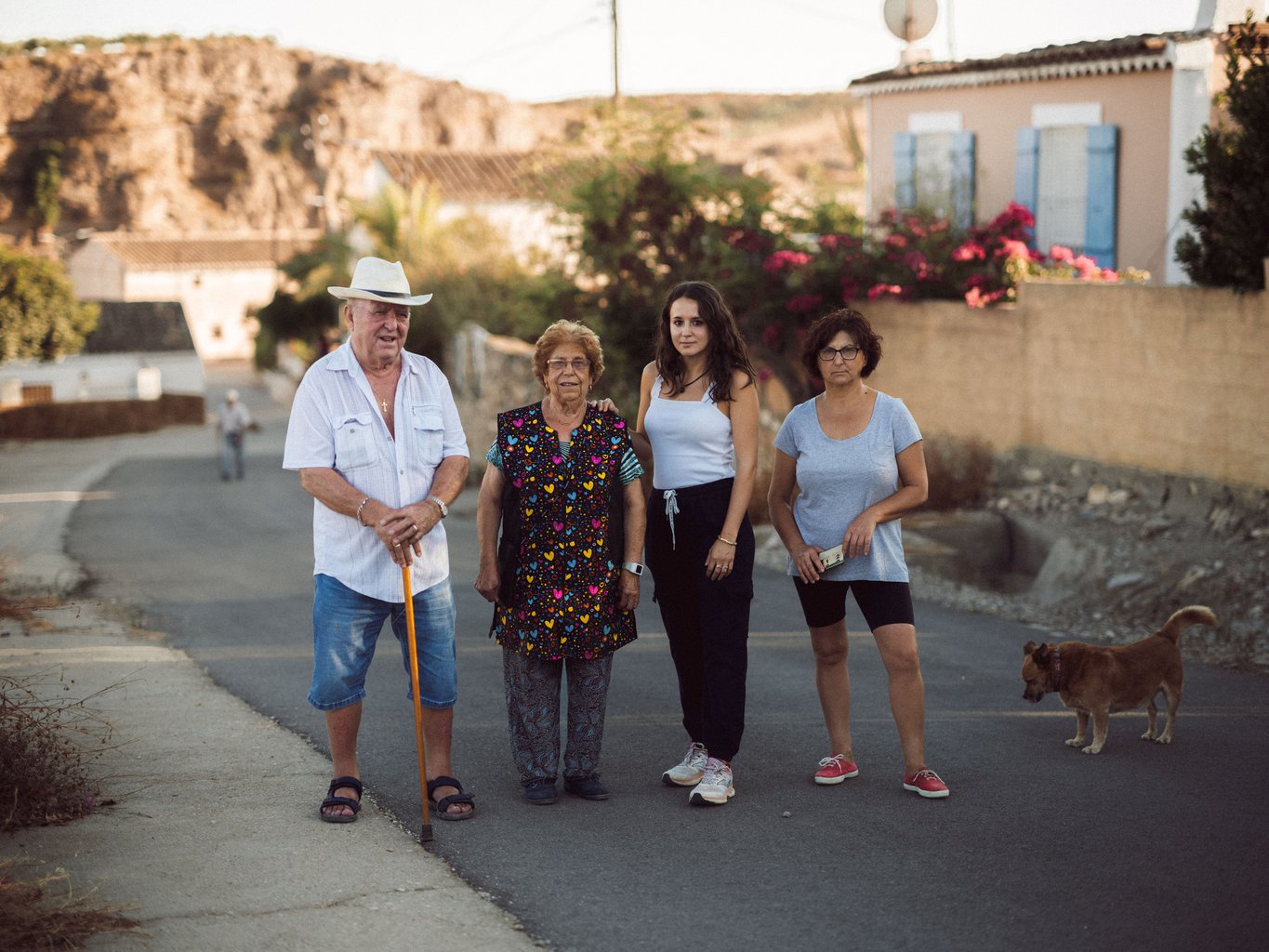
Former Moras mayor, Juan José Martínez (left), with his niece Juani (centre-right) and her daughter, Lorena (right). (Credit/Ian Howorth)
Evil Olives and the Miracle of Almería
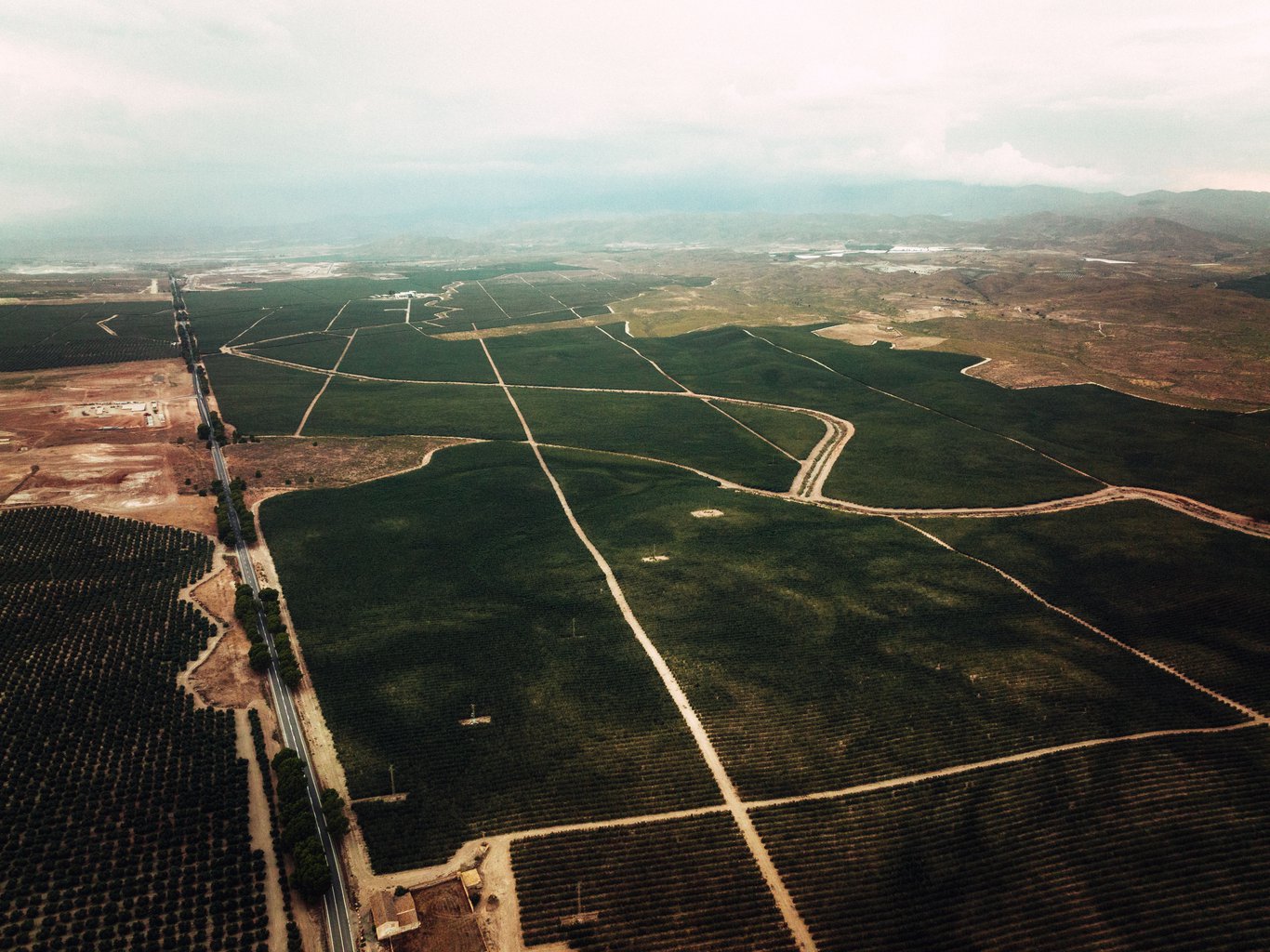
Aerial shot of olive plantation around Tabernas-Sorbas. (Credit/Ian Howorth)
Moras is situated on the edge of the Sorbas area of Almería, close to the Tabernas desert. For miles in every direction stand millions of olive trees, all neatly planted in rows. According to a 2018 study by the University of Almería, the Sorbas-Tabernas olive industry has “expanded dramatically” over the past 20 years from tens of thousands of trees to over 6.6 million, most packed into one 5000-hectare zone. The profit incentive of Almerían olives has created a dense monoculture that relies on the scarce resource of water.
Farms are dipping into Sorbas water at an unsustainable rate of up to 20 billion litres annually, four times the rate Sorbas can regenerate naturally through rainfall, leading to a crisis in the area. The Los Molinos del Río Aguas, the primary egress of the Sorbas aquifer, is now dangerously low, with the same study claiming a drop in outflow from 40 litres per second twenty years ago to seven. Activists and scientists claim the olive groves are a significant threat to biodiversity that will end with an irreversible slide into desertification.
Almería’s agriculture has helped propel Spain to the biggest producer and exporter of fruit and vegetables in the EU – and fourth globally. Germany, France, and the United Kingdom are its biggest importers. Plastic greenhouses dominate the coastline and entire towns. Over 30,000 farming companies work on nearly 50,000 hectares, generating up to 3.5 million tonnes of produce worth over €1.5 billion. It accounts for more than half of Andalusia’s entire agricultural sector.
This prosperity has come at a cost. We visited Almería several times over the past year and interviewed dozens of scientists, farmers, activists, and politicians. What emerged is an uneasy picture - sometimes of outright denial – of an economic success story built on environmental exploitation.
The chronic abuse of North African migrant labourers has created rampant inequality and social problems, including shanty towns. Decades of pesticides and fertilisers have poisoned the soil and rendered much of the water supply undrinkable. The plastic greenhouses that make all of this happen generate 33,000 tonnes of dumped waste each year, much of it disposed of illegally and is soon transformed into microplastic dust, polluting the land.
But posing the most significant threat is the overexploitation of the aquifers. The science is unanimous. Almeria’s water rush has led to the plundering of underground water at a rate many times higher than they can be replenished. Each year, levels run perilously low. Increasing salt levels from the Mediterranean rendered much of what remains undrinkable and ill-suited for irrigation. Desertification has already begun.
As far back as 1985, Spain’s Water Commission warned that the aquifers were in bad condition. In 2004, authorities officially declared the Nijar aquifer to have reached its “overexploitation level”. A study in 2014 by a doctoral student at the University of Almería estimated that without drastic action, it could be exhausted in 10 to 15 years. There are similar stories across Almería’s seven largest aquifer systems.
As one local activist tells us: “One day, the water will just stop.”
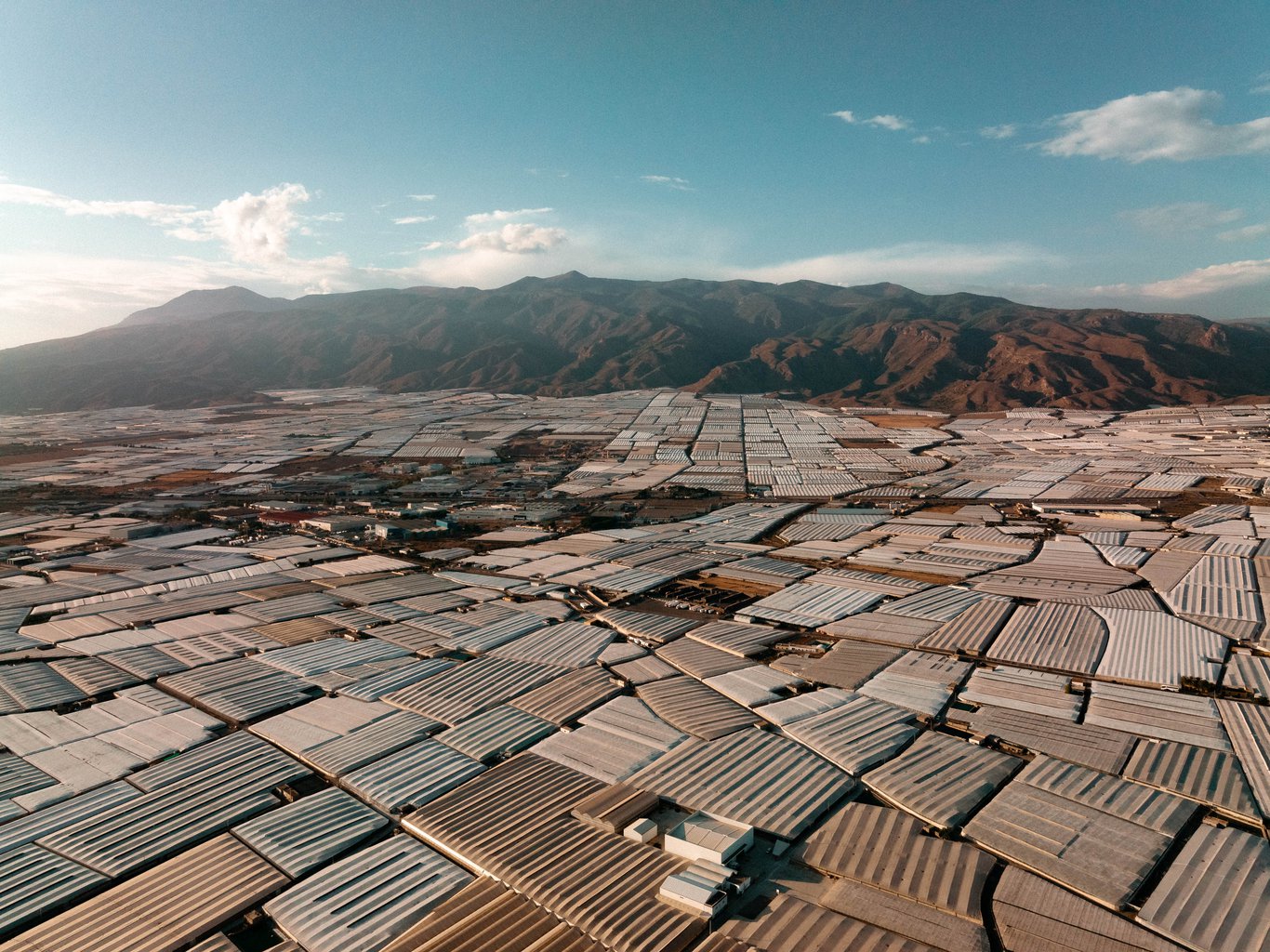
El Ejido's greenhouses, in western Almería. (Credit/Ian Howorth)
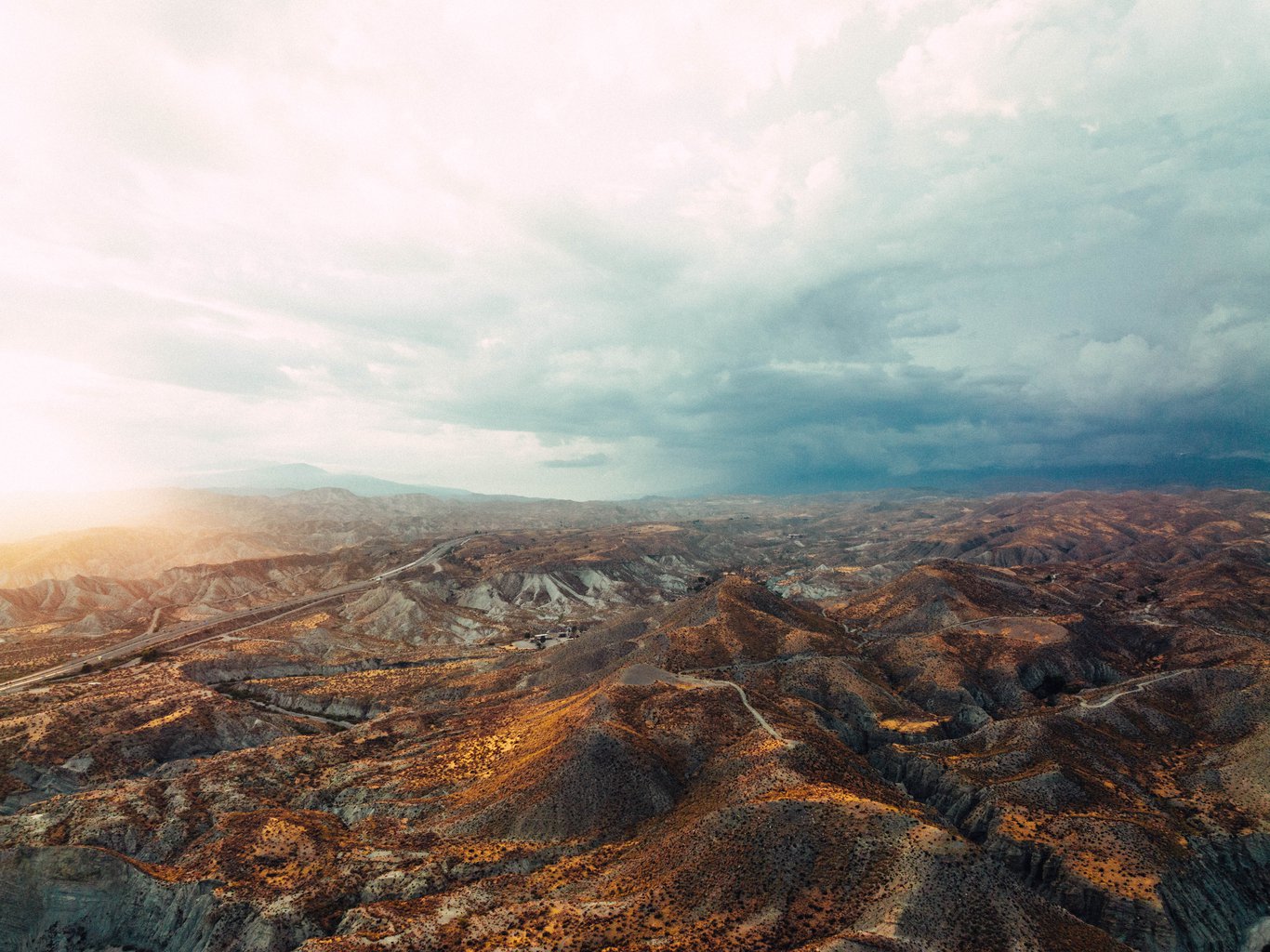
The iconic Tabernas desert, one of the driest areas in Europe. (Credit/Ian Howorth)
The Garden of Europe
The consequences of such an event will be devastating, environmentally and socio-economically. The collapse of small and large farming businesses could well cause mass disruption not only to millions of farm workers but also in supporting sectors, like transport and logistics, construction, cafés and bars, retail, and banking. Europe would lose a significant source of food.
Despite thirty years of warnings, successive Spanish and Andalusian governments, both on the left and right, have failed to meet targets designed to prevent collapse or reverse the damage. The EU has declared Nijar and Campo Dalías, the two coastal aquifers, as Nitrate Vulnerable Zones because of the overuse of chemical fertilisers.
In 2021, after complaints from activists and the European Commission, the EU Court of Justice found the Spanish government guilty of failing to protect groundwater from farmers in Doñana National Park - a case that became a cause célèbre for the right-wing during the recent snap elections. While Doñana’s water made international headlines, neighbouring Almería’s ongoing crisis has yet to attract the same attention.
“Whenever activists try to denounce companies and actors for theft or other violations,” says Pepe Rivera, from Almería’s first-ever environmental NGO, Grupo Ecologista Mediterraneo (GEM), “they are called anti-Almería. They are against the miracle of Almeria.”
In 2016 and 2017, GEM, with other activists and scientists, lodged criminal complaints against two of the biggest olive companies in Sorbas-Tabernas, close to Moras village. They documented evidence that two companies, Castillo de Tabernas and Gespater had stolen billions of litres of water for their olive plantations. Andalusia’s environmental agency pursued both cases with differing results. The court found Castillo guilty and fined it €500,000. A judge threw out the Gespater case.
Pepe Rivera says these cases have a mixed effect. “Once a company is found out, they simply continue to steal the water because they think, ‘Well, I’m caught. I may as well continue,’” he says. “Even if you are fined €1m, it is still significantly less than the profits you will make.”
It is, he tells us, almost impossible to turn off the tap, even in the cases of stolen water. The slow death of the Sorbas aquifer is mirrored across Almeria, a province famously known for its full-throated embrace of agriculture, as the Garden of Europe.
A Water Rush Boomtown
It sprouted in the late 1950s when the Franco government of Spain found vast lakes of underground freshwater beneath Campo de Dalías, a 300-square mile patch of coastal Almerían scrubland. It was a miracle. Almería is – then and now – the driest climate in all of Europe, home to the Tabernas desert.
So famous are its valleys and plains that they have provided the backdrop for countless Hollywood movies set in the desert, from Lawrence of Arabia to Cleopatra and the Spaghetti Westerns. More recently, television shows, including Game of Thrones, have seen landscapes in the region fit to depict desert wasteland and hopelessness.
The barren beauty had been a real-world curse, too. For generations, Almería was a land of peasants and small farmers who were the poorest citizens in Spain. Plagued with low rainfall and infertile, sandy soil, they were unable to grow anything but meagre yields of rainfed ‘dry crops’ – grapes, olives, maise, beetroot, cotton.
This was about to change drastically. Under Franco's long-term hydrological reforms, the government gave locals two-hectare land plots for cultivation. Thousands of water concessions were granted around El Ejido, the main town in Campo de Dalías, but farmers hardly needed them. Boring illegal wells into the aquifer was cheap, easy, and came with little oversight.
Water became pivotal for Franco’s campaign to pacify traditional Republican strongholds, and, as geologist Dr. Elena Lopez Gunn wrote in her 2009 study “Water for All,” intended to “unify key powerful sectors” like “large farming interests, the technocratic elites, fascist movements, the army and the Church under a common banner.”
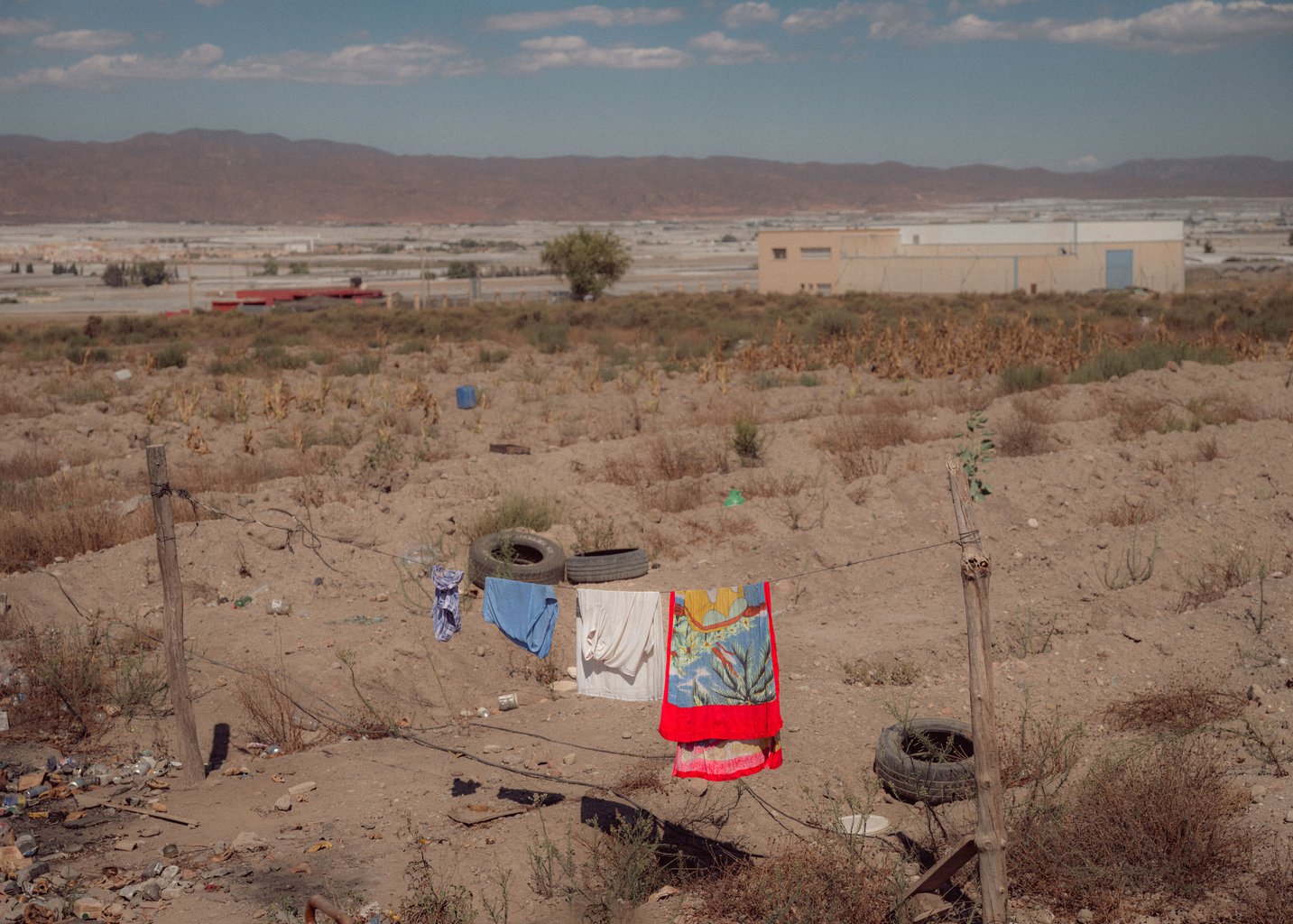
Greenhouses in Campo de Níjar, one of the most intensive farming areas of Spain, where the aquifer is all but destroyed (Credit/Ian Howorth)
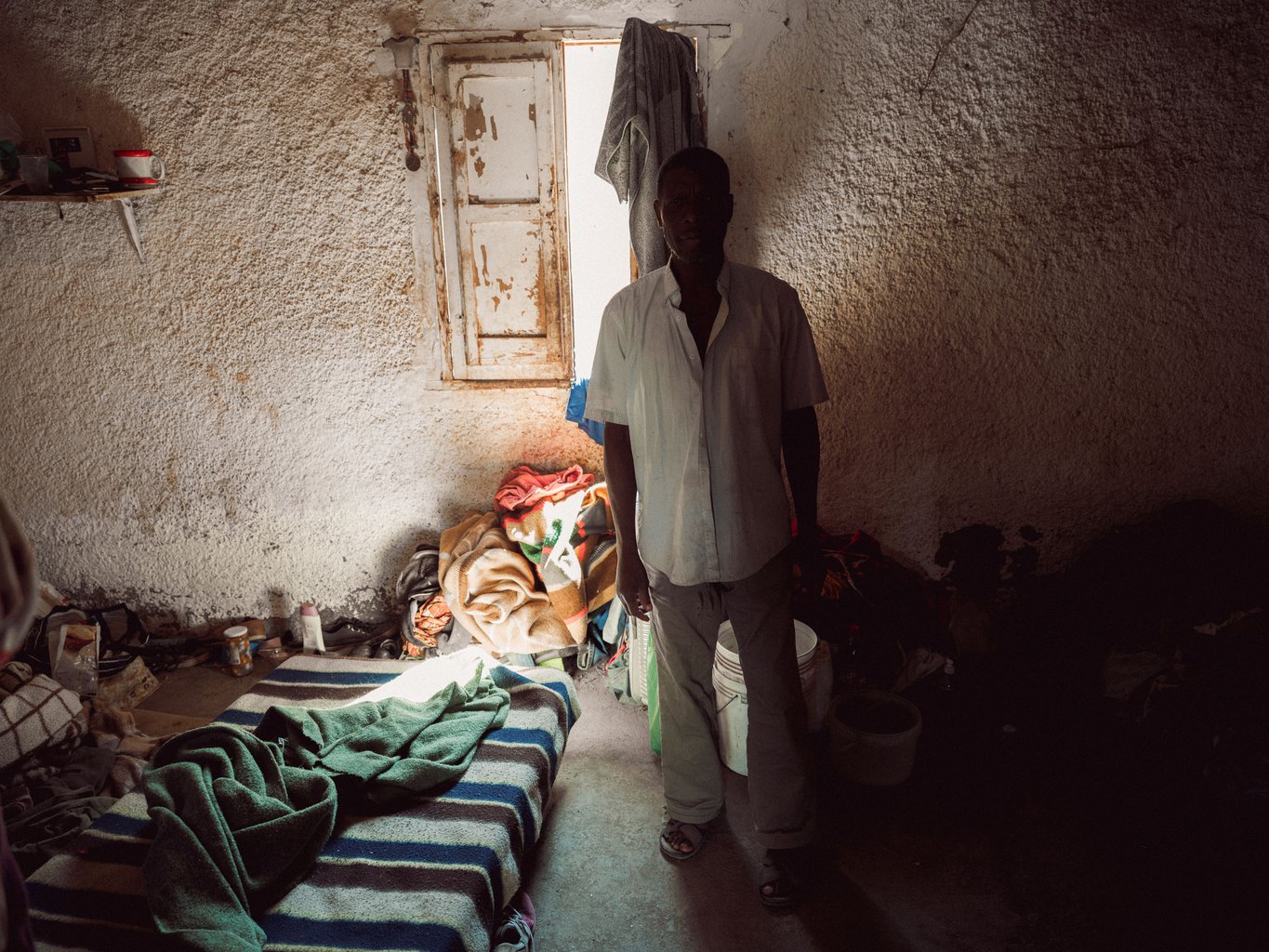
The "Miracle of Almería" is also based on the mass exploitation of migrant labour, mostly from North Africa, who are forced to live in slum-like conditions. (Credit/Ian Howorth)
Over the next decade or so, new aquifers were tapped across Almería during a ‘colonisation period’ of drilling, as it is sometimes called. This transformed countless poor families into self-sufficient farming families. Yet, it was the addition of another, this time accidental, discovery that changed the region's fortunes entirely.
“To protect the crops from the harsh desert sun and winds, farmers covered them in plastic sheet greenhouses,” says Manuel Pérez Sola, a retired local teacher and Acuíferos Vivos activist. “This helped farms to greatly diversify their crops and boosted yields by two or three harvests per year.”
For the first time, many Almeríans could live off the land and sell produce to local markets, he says, and villages cropped up around these new agricultural communities. They built roads, schools, and churches and eventually organised cooperatives, which controlled the quality, distribution, and workforce, pooling their yields for sale and splitting the profits.
By the 1980s, this model of worker-owned enterprise made way for pure capitalism as agribusinesses caught on to the profit potential of Almería. Pérez says that this “new system produced more crops, so [farmers] had more to sell” and so “began the exportation of products to Europe.”
Spain’s accession to the European Union in 1986 accelerated the greenhouse boom. Accession brought development aid from Brussels and opened markets. Almería became an agricultural Klondike, with the “intensive farming” culture growing from 500 hectares to 20,000 hectares in a decade.
Boomtowns popped up. Pepe Rivera explained that during these times, in the late 80s and early 90s, there were hardly “fully functional roads. But there were Gucci and Louis Vuitton stores along the streets.” For hundreds of square miles around El Ejido and Nijar, a dystopian sprawl of plastic greenhouses grew as far as the eye could see. The Miracle of Almería had begun.
The biggest water exporter in Europe
When two-year-old Julen Roselló died in 2019 after falling 100 metres into an illegal borehole in Totalán, the public grief caused a brief crackdown on water theft by farmers. In 2006, the Spanish Ministry for the Environment said there were more than 500 thousand illegal wells in Spain. Activists put the number at likely twice that, even today. Almost two decades later, no new reliable data have emerged.
José María Calaforra, a professor of Biology and Geology at the University of Almería, who has studied Almería’s aquifers extensively, says that illegal wells are not the core of the problem. “It's absurd that the place where we have the least water is the biggest water exporter in Europe,” he says. This precious resource leaves Almería “in peppers, cucumbers, tomatoes, watermelons, melons,” Calaforra adds. He says to grow a single watermelon takes hundreds of litres of water.
Almería has the lowest rainfall in Europe. There are no rivers and little surface water. Groundwater is essential to farming, and over 85% of it goes to agriculture, which, through technological advances, has become adept at squeezing the most vegetables from every drop through drip irrigation and other water conservation methods. But all the frugality in the world cannot compensate for the sheer number of companies in the area that hold water concessions.
“Since the 80s,” says Calaforra, “the authorities have given more water [to farmers] than we actually have as a resource.” In some places in Almería, the water permits issued since the enactment of the 1980 Water Law are four times more than the actual water that exists.
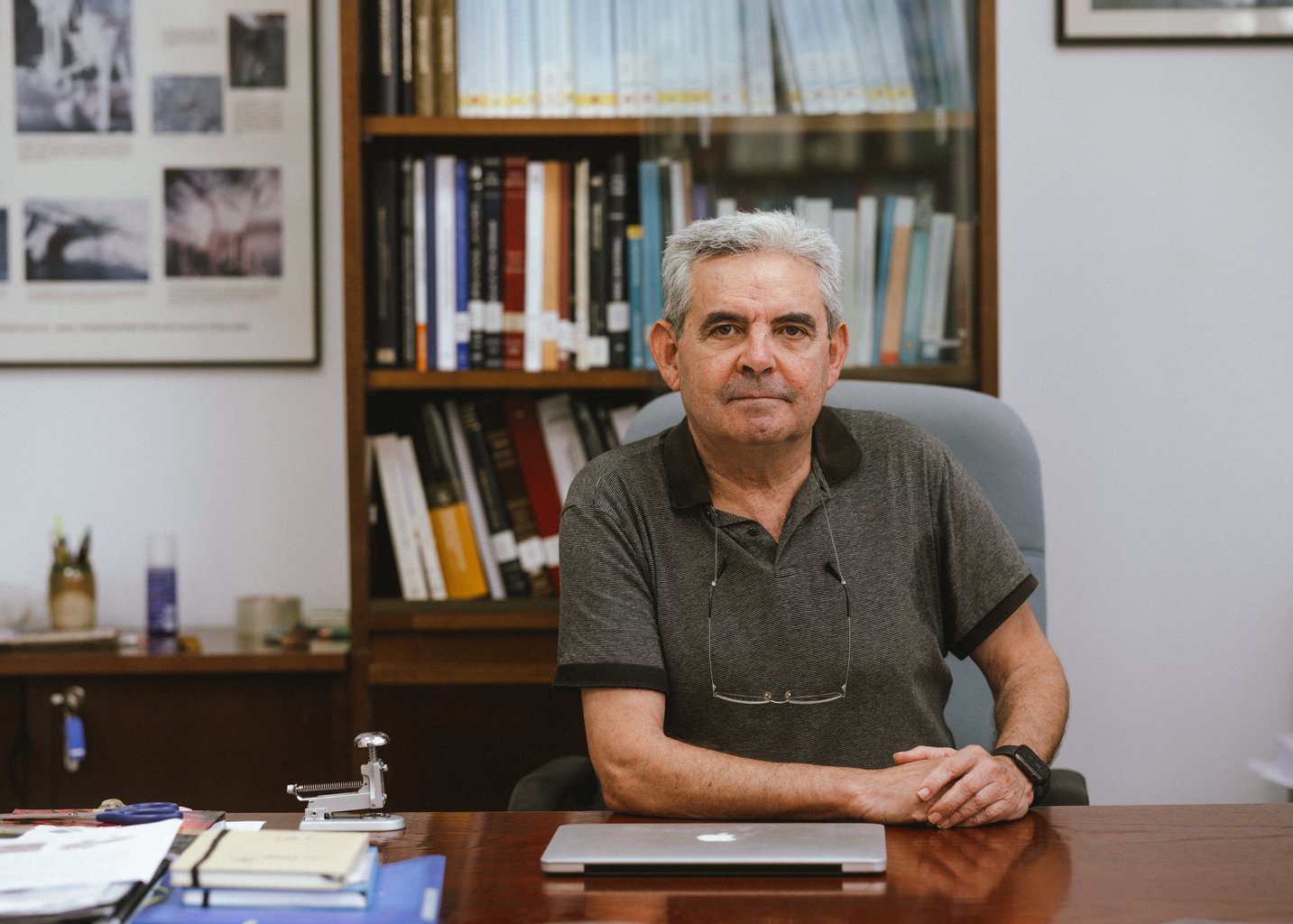
Professor Calaforra, of the University of Almería, has studied the region's aquifers for decades. (Credit/Ian Howorth)
Politics of Water
“Water has become an ideological turf war,” admits Juan Francisco Rojas Fernandez, councilman and spokesperson for the far-right VOX party in Almería. It is a conflict that VOX has been increasingly willing to participate in over recent years, even proposing the amnesty for the illegal strawberry farmers in Doñana that caused a mini-diplomatic scandal this past summer.
During his interview for this story, Rojas readily concedes that Almería’s “aquifers are overexploited,” but the farmers, he says, are responsible for “turning this desert into an orchard.” The problem of water “must be solved so that the main economic activity of Almería can continue.”
It is hard to find anyone in politics prepared to criticise a farming culture that has pushed Almería to breaking point. Discussions shift instead to safer ideological ground that has echoes of past politics in Spain, going back decades to Franco times.
VOX’s solution calls for a “national hydrological plan” that will unite Spain through “interbasin water transfers,” Councilman Rojas says. In practice, this means taking water from one area of Spain and gifting it to another. It will “unite” the country “just as the United States did with the railroad,” adds Rojas.
The idea of water transfers has been controversial for decades in Spain. In 2001, the conservative People’s Party’s (PP) plan to transfer 450 billion litres of water annually from the Ebro River to the country’s agricultural hubs of Valencia, Murcia, and Almería led to protests across the country. Over 400,000 people marched in Madrid and another 250,000 in Zaragoza. Protests even reached Brussels in opposition to the EU’s role as a financier.
Even today, however, the resistance is fierce. Some northerners say they would rather form a terrorist group than give up their water just so farmers in Almería can continue to export vegetables to the rest of Europe.
The Ebro-Almería interbasin project was never completed (there have been transfers from the Tagus to Almería for over 40 years ). The PSOE socialists, who had campaigned against it, came to power in 2004 and threw out the plans of their PP predecessors. What’s rarely mentioned is that the PP themselves had inherited the policy from the socialists.
Antonio Martínez, PSOE senator for Almería, which has governed Andalusia's parliament for much of the past 40 years, praises the farmers for overcoming their climatic and geographical “situation”. He calls the greenhouses the “flagship of the province” and says the lack of water is a decades-old problem caused by climate change and structural issues not unique to Spain.
Prime Minister Pedro Sánchez is “betting” on recycled water. “That is to say water mainly from desalination,” says Martínez, extracting seawater from the Mediterranean and removing the salt. In other words, the Agua Plan.

Antonio Martínez, PSOE senator for Almería, say the national government is betting on desalination. (Credit/Ian Howorth)
Farmers are especially angry at the proposals to curtail their low-cost access to the aquifers that will force them to pay for expensive desalinated water. Even with huge state subsidies, Almería pays the highest rate in the country, around €1 per cubic litre (a thousand litres). Since the Russian invasion of Ukraine, the cost of the electricity needed to power the plants has risen sharply, and so has the desalinated water.
VOX’s Rojas dismisses them as expensive, polluting, and only embraced by other parties out of “ignorant ideological ecologism” while ignoring recent reports that those areas proposed for transfers, like Ebro, today suffer from “extreme drought”.
"The problem with desalinated water,” says Pepe Rivera, “is that it is expensive. And that is why [farmers] prefer cheaper water, which is water from wells or water from transfers, legal and illegal”.
He adds, "If the irrigated area [in Almería] continues to grow, the entire [AGUA] plan will be useless."
Last summer’s water crisis led the Spanish government to force through a €2.2 billion emergency plan to save its agricultural sector, 64% of which (€1.4 billion) is earmarked for desalination plants. It was announced around the same time as its petition to the EU for emergency funds from the bloc’s Common Agricultural Policy to help farmers recover from last year’s drought and record temperatures.
The 2004 Agua Plan promised billions for desalination plants, including five in Almería, up from two. Twenty years later, these desalination plants have not materialised. The latest EU Water Framework Directive report into the state of Spain’s national water says that the country has failed in almost every category. Its aquifers are worsening rather than improving. Still, the amount of farmland continues to grow.
Abandonment
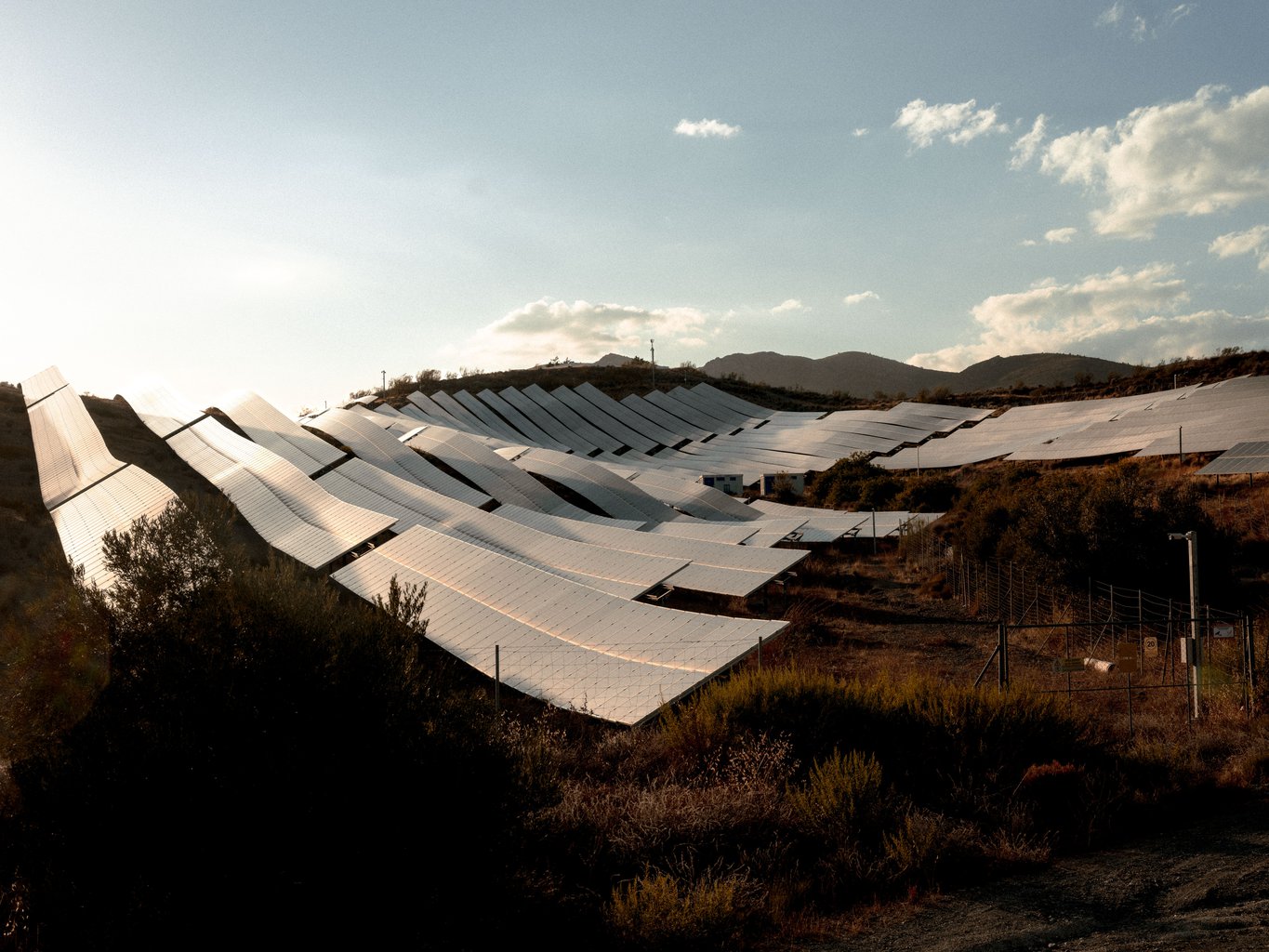
The new exploitation. Solar farms are cropping up around the Sorbas-Taberas area. (Credit/Ian Howorth)
In places like Moras, the landscape is changing once again. Olive trees in the wild typically last for centuries. The oldest in the world is in Crete, which is thought to be 4,000 years old. The olive trees in Sorbas-Tabernas, outside Moras, won’t last that long. Intensive farming methods and higher yields restrict their lifespan to around 15 years. And their time is at hand.
But the sun still shines in Almería. With degraded soils and a lack of water, some of the olive companies there are already selling their land for solar farms, which are becoming increasingly visible in small villages and hillsides across Sorbas and Tabernas. Activists oppose the plans, warning that the solar panels further harm soil recovery and will require billions of litres of water to maintain without providing cheap, clean energy for locals (the electricity is destined for France, locals say).
It is a sign of things to come. Calaforra tells us that what is at risk in Almería is abandonment. “If you don't have water, everybody moves away,” he says. “If you want to maintain this agricultural resource, you have to look for other water resources to try to support it. If that doesn't happen, then obviously you collapse.”
Last month, on 27 November, the PSOE, which survived the snap election and even increased its vote share, signed a deal with the People’s Party government in Andalusia over Doñana. To quell farmers’ growing anger, they have agreed to pay farmers €70,000 per hectare to transform their farmland into forest areas and halt groundwater extraction. The cost is €1.4 billion.
The opening scene of the 2017 science fiction film Blade Runner 2046, starring Ryan Gosling, features a long aerial shot of an environmental wasteland. Set 25 years from now, it portrays a hostile world devoid of natural vegetation and beauty, where humanity’s food is grown beneath a vast expanse of plastic greenhouses. The shot was real, made in Campo Dalías, where Franco’s geologists tapped into Almería’s first aquifer almost 70 years ago. Dystopian art intends to act as a cautionary tale for modern society. In the case of Almería and its land, the question is whether it will even survive until 2046. Should it manage to do so, it will become the new miracle of Almería.
Supported by JournalismFund Europe
